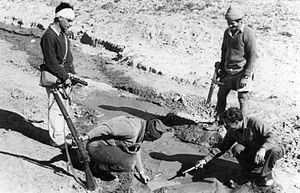Simcha Blass
Simcha Blass (November 27, 1897 – July 18, 1982; Hebrew: שמחה בלאס) was a Polish-Israeli engineer and inventor who developed the modern drip irrigation system with his son Yeshayahu.[1][2]
Biography
Simcha Blass was born in
Later, he invented, patented and developed an operative wheat planting machine, which was tested and sold in Europe and in Palestine (1927), but proved uneconomical. The main motivation for this invention was Zionism (i.e. enabling more Jews to settle in Palestine). Zionism was the main drive for most of his other activities in adult life.[4][2]
Water engineering in the Yishuv of Palestine and State of Israel
During the years 1930–1948 he was the most known water engineer in the Yishuv (Jewish community) of Palestine. He planned the first modern aqueduct in the Jordan Valley. He was the chief engineer and one of the founders (with Levi Eshkol and Pinchas Sapir) of Mekorot water company (established 1937, now Israel's national water company).

Later, in 1946, he planned the first water
In 1948 to 1956 Blass was the founder and director of the governmental water institutions of the newly established State of
Blass wrote the chapter "Development of Water Resources in Palestine" in Encyclopaedia Hebraica.
Drip irrigation
In the early 1930s, a farmer drew his attention to a big tree, growing in his backyard "without water". After digging below the apparently dry surface, Simcha Blass discovered why: water from a leaking coupling was causing a small wet area on the surface, while an expanding onion-shaped area of underground water was reaching the roots of this particular tree—and not the others. This sight of tiny drops penetrating the soil causing the growth of a giant tree provided the catalyst for Blass's invention.[6] The drip irrigation concept was born and experiments that followed led Blass to create an irrigation device that used friction and water pressure loss to leak drops of water at regular intervals. Recognizing the high potential of his discovery, he began to look for ways to turn his idea into a product.
In the late 1950s, with the advent of modern
During the years 1960 to 1965 Blass developed the drip-irrigation systems and sold them inside Israel and abroad. In 1965 he contacted Arie Bahir who was in charge of the industry in the kibbutzim in order to find a
Online dripper system
For the desert-based Kibbutz Hatzerim looking to expand its activities beyond agriculture, Simcha Blass's invention opened up a world of possibilities. Blass and his son Yeshayahu and Kibbutz Hatzerim signed a contract (on August 10, 1965) establishing Netafim Irrigation Company (80% Kibbutz Hatzerim and 20% Blass).[8] Production began in 1966. With Blass's original narrow spaghetti tube model and later models as the starting point, Netafim engineers working with Blass, developed the online dripper—indeed allowing the desert to bloom.
Published works
- Water resources in Israel (Hebrew: אוצרות המים בארץ ישראל), Mekorot, May 1944
- Water in Strife and Action (Hebrew: מי מריבה ומעש), Massada, 1973 (autobiography)
References
- ^ Blass, Simcha (1973). Mei Meriva u-Ma'as (Water in Strife and Action) (in Hebrew). Givataim: Masada Press.
- ^ ISBN 978-1-886223-06-6.)
{{cite book}}: CS1 maint: location (link - ^ "Water in Strife and Action", part 1 (pages 41-67)
- ^ "Water in Strife and Action", part 2 (pages 68-87)
- ISBN 978-0-520-93649-2.
During the summer of 1946 the British imposed an eighty-hour curfew on Tel Aviv and arrested scores of Zionist activists ... Eshkol ... sought a creative form of revenge. The night after Yom Kippur, he staged a lightning campaign, creating eleven new Negev settlements on JNF lands. ... Together the pipes could carry only a million cubic meters of water a year, but stage one of Arthur Rupin's desert fantasy was complete
- ^ History of micro-irrigation in landscape turf
- ^ "Water in Strife and Action", page 351
- ^ History of drip irrigation
External links
- Special Collection Stanford University Library
- Touro CollegeLibraries. p. 2945.
